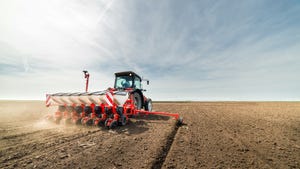
Southwest farmers looking for ways to pencil in a profit for wheat as they prepare to plant this fall have limited options, and observers do not expect prices to improve by harvest time next spring.
Caution is called for.
Texas A&M AgriLife Extension small grains specialist Clark Neely understands the dilemma—cutting back on inputs risks limiting yield and profit potential. Skimping on nitrogen, he says, may not result in significant yield loss, “but if we do get rain and the crop yields, protein level may be low, and producers will be docked at the elevator. I heard more about elevators not wanting low protein wheat this year than I have in several years.”
Quality may be a key to making even a little money on wheat this year. “A lot of wheat remains in the supply channels, but we may be short of high quality wheat,” Neely says.
Low prices, he adds, likely will put a cap on wheat acreage. “I don’t think we will plant more, but we probably will maintain acreage. A lot of farmers may plant wheat for grazing, even though the cattle market has also softened a bit.”
Producers may save a few dollars on seeding rate, Neely says. “If producing for grain, 50 to 60 pounds of bin run seed can make as good a yield as 90 pounds per acre. But we have some farmers who want to plant 90.”
It’s different for grazing. “Producers will make more forage with higher seeding rates.”
He says fungicides will pay “in most cases. Many farmers are now automatically applying a fungicide, like tebuconazole, because it is inexpensive. Some products will do a better job and have more modes of action, but they cost more. With low prices, producers may want to consider reducing exposure to higher costs and more risk.”
JUDICIOUS USE OF FUNGICIDES
Neely does not recommend a fungicide if no disease is present. “But some will add it as they topdress. Early application makes no real difference in control,” he adds.
Planting date is another factor a farmer can control (depending on weather) with no added cost. “Plant early if planting for grazing,” he recommends. “Plant later if growing grain.”
Late planting limits the time young wheat is vulnerable to several insect pests, including green bugs and Hessian fly, which was a serious pest in some locations two years ago.
That brings up another critical point, Neely says. Variety selection is a decision that doesn’t add significantly to production costs but can make a substantial difference in yield and quality. He recommends that producers look at the Texas AgriLife Extension ‘Picks List,” developed every year from variety trial performance data.
Varieties are rated on yield, disease resistance and tolerance to pests, such as Hessian fly. The full list of “Picks” across the state and performance data can be found at http://varietytesting.tamu.edu/wheat/.
[See also: http://www.southwestfarmpress.com/wheat/wheat-variety-picks-offered-statewide-texas-am-agrilife.]
The bottom line, Neely says, is that producers have to plan on making a good yield. “They have to invest in the crop.”
Nonetheless, many may look at the wheat budget and the market outlook and find they can’t see how wheat will pay this year.
ALTERNATIVE CROPS
“Maybe some should consider a different crop,” Neely says. Canola may be a promising option. “With canola prices at about $7.50 per bushel, if a grower doesn’t stand to make money on wheat, he doesn’t have much to lose by trying it.” Neely says canola acreage has increased a bit the last few years, with more planted around Vernon and Ballenger. “It’s a good rotation crop,” he adds. “And it helps control weeds that are troublesome in wheat.”
One downside is transportation. “We don’t have local delivery points, and the nearest may be Lubbock. Rolling Plains producers may have a delivery point near Vernon.”
Other options include sesame, oats, and barley.
Sesame shows promise as a double-crop option. “It is super drought tolerant after it gets established,” Neely says. “Sesame does not like ‘wet feet.’ It doesn’t do well with too much water.”
He says Sesame shows promise for Texas. Acreage peaked at 100,000 several years ago. “It may have dipped a little last year.” Most production is on contract.
Barley acreage was up a little last year at 45,000 acres. “Most is grown for grazing.” Some goes into the brewing industry, serving micro-breweries in the state. That demand could grow, he says, as the breweries grow.
“Oat acreage is planted mostly for grazing with a small percentage for grain.”
Neely makes one strong recommendation for a change in wheat production for South Texas. In two straight mild winters vernalization was inadequate, and winter wheat was not a good choice. He recommends switching to spring wheat. “We are encouraging more spring wheat in South Texas. Spring wheat has no vernalization problems.”
He says yields are as good as or better than winter wheat varieties in the region. “We will start variety trials in college Station. We are not afraid of freeze out. It does not get cold enough here.”
About the Author(s)
You May Also Like






